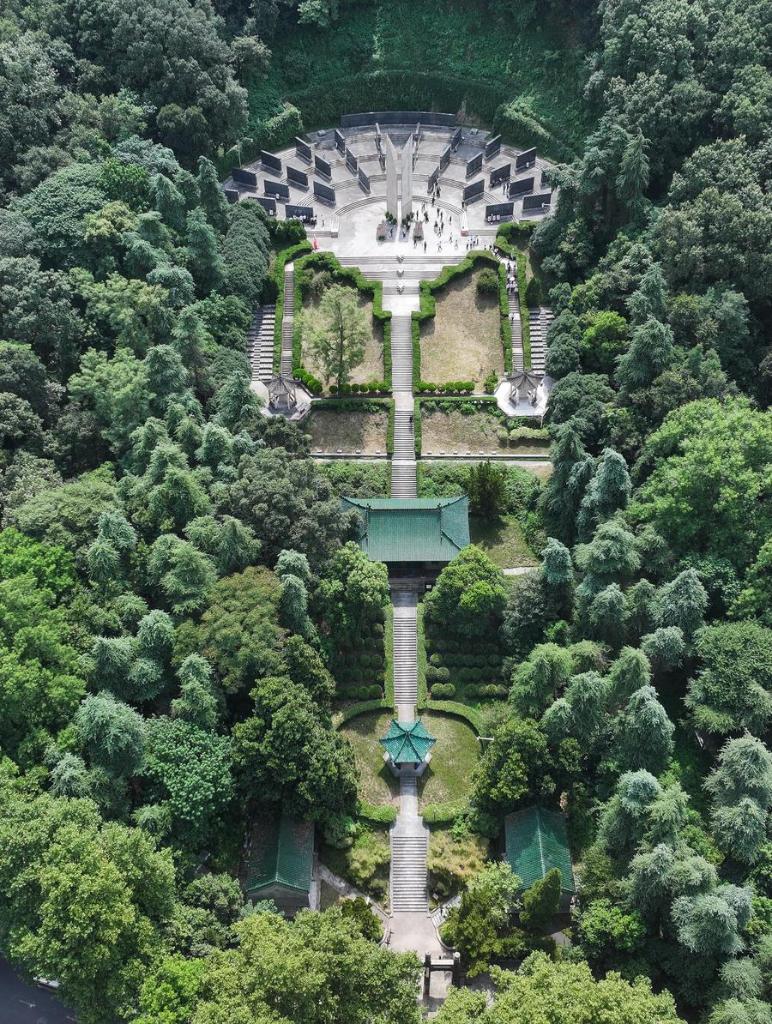
An aerial drone photo taken on Sept. 3, 2024 shows a view of the cemetery of the aviation martyrs in Nanjing, capital of east China's Jiangsu Province. (Xinhua/Ji Chunpeng)
NANJING, Sept. 3 (Xinhua) -- China released a list of 2,590 anti-Japanese aviation martyrs from the United States for the first time on Tuesday, most of whom were from the Flying Tigers, according to the Nanjing Anti-Japanese Aviation Martyrs Memorial Hall in east China's Jiangsu Province.
Published on the official website of the Dr. Sun Yat-sen Mausoleum Administration Bureau, this list discloses the names, dates of death and military positions of these Second World War martyrs, with adjustments and amendments based on research.
The Flying Tigers, officially known as the American Volunteer Group of the Chinese Air Force, was formed in 1941 by General Claire Lee Chennault of the United States. They came to China to help Chinese people fight the invading Japanese troops.
Later, the Flying Tigers refers to all U.S. Air Force personnel who came to China to stand shoulder to shoulder with the Chinese people in fighting the invading Japanese troops from 1941 to 1945, said Dou Ruoqi, a staff member of the memorial hall.
The information about the 2,590 American anti-Japanese aviation martyrs was engraved on the monument in the memorial hall in 1995 and 2015. However, due to the passage of time and the absence of original archives, much of the information about these martyrs is incomplete and difficult to verify.
"We hope that the release of this list will mobilize efforts both domestically and internationally to enhance the collection of historical materials, conduct further research and promote the legacy of American anti-Japanese aviation heroes. This will help identify and correct errors on the monument and recover missing information about these heroes, making the list more complete," said Dou.

Chairman of the Sino-American Aviation Heritage Foundation Jeffrey Greene tells the stories of Jack W. Hammel, a U.S. pilot, at the Nanjing Anti-Japanese Aviation Martyrs Memorial Hall in Nanjing, east China's Jiangsu Province, Sept. 3, 2024.(Xinhua/Ji Chunpeng)
On the same day, the memorial hall announced the addition of Jack W. Hammel's name to the monument. Hammel, a pilot from Michigan, died at the age of 23 on July 25, 1945, in east China's Jiangxi Province, after his fighter plane was hit by Japanese ground fire.
In 2017, Hammel's family and friends visited the memorial hall but couldn't locate his name. With assistance from the Chinese Embassy in the United States, the Sino-American Aviation Heritage Foundation and other institutions, Hammel's identity was confirmed and his name has been added to the monument.
Also on Tuesday, the launching ceremony of "Remembering Heros: Flying Tigers Photo Exhibition Tour (Nanjing)" was held at the memorial hall. The exhibition showcases approximately 180 photographs and over 100 cultural relics, including General Chennault's medals.
Chinese Ambassador to the United States Xie Feng addressed the ceremony via a short video. He said the story of the Flying Tigers marks an indelible episode in the world anti-fascist cause.
"The bond our two people forged amid the trials of blood and fire has been a constant source of inspiration for the China-U.S. relationship. And the spirit of the Flying Tigers, which remains as relevant as ever, has been and will continue to be our common treasure," he said.
Flying Tigers veteran and centenarian Robert Moore said in a video speech from home: "It was the fact that we were cooperating that the Chinese and Americans were working together to defeat the Japanese. It is my sincere wish that this cooperation will continue."

Vice Chairman of the Sino-American Aviation Heritage Foundation(SAAHF) Clifford R. Long Jr. (C, front), also son of pilot Clifford R. Long Sr., and Consultant Thomas Kincannon (1st R, front) visit the former residence of John Rabe, a German businessman who helped protect hundreds of thousands of Chinese during the Nanjing Massacre, in Nanjing, east China's Jiangsu Province, Sept. 2, 2024. (Xinhua/Ji Chunpeng)
So far, approximately 500 Flying Tigers veterans and hundreds of their family members have visited China, promoting the spirit and fostering an enduring friendship between the Chinese and American people.
Clifford Long Jr., the son of a Flying Tigers pilot, pointed to a case with tears in his eyes. In this case, a uniform, a hat, and a pair of aviator glasses worn by his father are on display.
His father, Clifford Long, joined the Flying Tigers at the age of 19 and flew 103 missions. Talking about his father, Clifford Long Jr. said, "His time over here was very impressionable on him. He came home with a tremendous love for the Chinese people, and he was always the rest of his life so honored and proud that he was able to come to China as a fighter pilot."
Margaret Kincannon, the daughter of a Flying Tigers veteran, believes that the example of cooperation with the Flying Tigers can be used today, "because if they could do it at that time with the differences in culture and language, then we can do it now."
The Nanjing Anti-Japanese Aviation Martyrs Memorial Hall is China's first international anti-Japanese aviation martyrs memorial hall. Its collection contains rich historical materials about the air forces of China, the Soviet Union, the United States and other countries that were jointly fighting against the Japanese invaders in China during the Second World War. The names of nearly 4,300 Chinese and foreign anti-Japanese aviation martyrs are engraved on the monument in the memorial hall.













